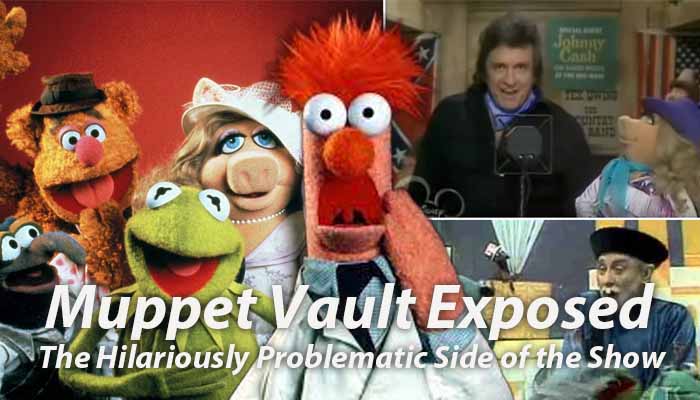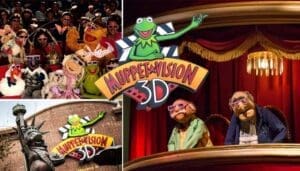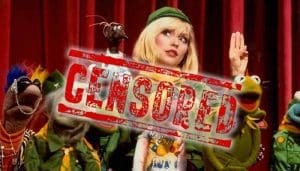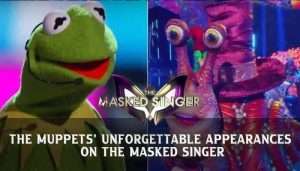Ah, The Muppet Show. A whirlwind of felt, fur, and celebrity guests who probably didn’t know what they were signing up for. Pure, unadulterated joy, right? Well, about that… For decades, this beloved variety show, which originally aired from 1976 to 1981, has been a cornerstone of wholesome family entertainment, a chaotic symphony of song, dance, and chickens clucking in the background. But then came the age of streaming, and with it, a little something from Disney+ that made us all lean in closer.
Imagine settling in for a dose of wholesome Muppetry, only to be met with a 12-second, unskippable disclaimer before certain episodes. This digital Post-it note basically says, “Brace yourselves, folks, some of this stuff did NOT age well”. The warnings, appearing on 18 episodes, soberly inform viewers that the program “includes negative depictions and/or mistreatment of people or cultures,” adding, with a delightful lack of ambiguity, “These stereotypes were wrong then and are wrong now”. It’s like finding out your sweet old grandpa used to tell really off-color jokes at parties, and Disney is the one awkwardly clearing its throat at the family reunion. This corporate “Yikes!” serves as an official permission slip, almost, to critically re-examine this beloved piece of nostalgia. If the House of Mouse’s legal team is breaking a sweat, perhaps it’s worth a look, preferably with a laugh track.
Now, let’s be clear. This isn’t a witch hunt, nor is it a campaign to cancel Kermit the Frog (though his management of that theatre was often questionable). We’re here to lovingly poke fun at the moments that make us go “Wocka Wocka Whaaat?!” Jim Henson, the visionary creator, generally aimed for progressive themes, and the Muppets often embodied a spirit of inclusivity. The Muppet Show was, after all, a global phenomenon, shown in some 100 countries. However, like finding a rogue pickle in your ice cream sundae, some elements are surprising, a bit weird, but don’t necessarily ruin the whole dessert… mostly. The very act of Disney adding these warnings highlights a broader cultural shift in how we consume and evaluate past media, making the Muppets, in their fuzzy, googly-eyed glory, a particularly amusing case study.
Guest Stars Gone Wild: When Celebrities and Muppets Cooked Up… Questionable Content
The Muppet Show managed to attract an astonishing array of top-tier talent from the 1970s and 80s. These collaborations often resulted in television gold. Other times, well, let’s just say the script might have benefited from another pass, or perhaps a ceremonial bonfire. The involvement of these big names often lent a veneer of acceptability to portrayals that, in hindsight, raise more than a few eyebrows, illustrating how celebrity can normalize, or at least fail to challenge, problematic contemporary norms. One can only imagine the pitch meetings: “Okay, esteemed guest, for this sketch, you’ll be interacting with a caricature that might just haunt your IMDB trivia page for decades. Sound good?”
Case Study 1: Johnny Cash and the Confederate Flag Fiasco (Episode 521)
Country legend Johnny Cash, the “Man in Black,” graced the Muppet stage in an episode that now comes with a side of historical discomfort. As Cash performed “Ghost Riders in the Sky” and “Dirty Old Egg Sucking Dog,” a Confederate battle flag was prominently displayed in the background. Nothing quite says ‘family fun’ like a symbol deeply associated with slavery and treason waving merrily behind a beloved singer and a gaggle of puppets. Was it “Heritage, Not Hate,” Fozzie? Or did the set designer just grab the first vaguely ‘country’ looking flag they could find at the prop house fire sale? To add a layer of ironic complexity, Cash himself was known for his support of Native American rights. So, progressive on one front, seemingly oblivious on another? It’s as complicated as trying to explain Gonzo’s species.
Case Study 2: Peter Sellers’ Unflattering Romani Holiday (Episode 219)
The comedic chameleon Peter Sellers, famed for his transformative roles, appeared on the show and, in one segment, transformed into… a walking, talking offensive stereotype. Dressed as a “wild gypsy,” Sellers used a derogatory term for Romani people and employed stereotypical garb and accent while performing the song “A Gypsy’s Violin”. The cringes? Unlimited. Did Kermit just shrug and say, “Well, he’s Peter Sellers, let him cook… up a cultural misfire”? It’s particularly poignant given Sellers’ famous line from this very episode, “There is no me. I do not exist. There was a me once, but I had it surgically removed”. Perhaps he surgically removed his cultural sensitivity for this bit. This episode is a prime example of how even celebrated artists could perpetuate harmful tropes, and the Muppets provided the stage.
Case Study 3: Kenny Rogers’ Arabian Adventure and Indigenous Insensitivity (Episode 410)
Kenny Rogers, the Gambler himself, seemingly gambled on some dicey material. The episode featured a “cold open” where Rogers is informed his dressing room has been sold to “Arabs” for mineral rights, a clear play on the stereotype of Middle Eastern people profiting from oil. Adding to this, Muppets portraying Arabs arrived on camels, not in cars, further cementing the trope. But wait, there’s more! The episode also paraded out a witch doctor caricature, complete with dreadlocks, tribal neckwear, and a wooden idol – a stereotypical depiction of healers in some Indigenous and African societies. It’s as if the writers had a checklist titled “Stereotypes to Offend in 22 Minutes or Less.”
Case Study 4: Spike Milligan’s World Tour of Wrong (Episode 317)
The brilliant but anarchic comedian Spike Milligan took viewers on an international journey… of unfortunate caricatures. A Japanese-themed number featured Japanese Muppets with exaggerated accents singing “We know we berong to the rand” (a play on “Oklahoma,” which became “Yokohama”), and Milligan himself later appeared in a Chinese outfit with buckteeth, chattering in mock-Chinese. The tour also included a stop in the Arctic to mislabel some Inuit Muppets as “Eskimos,” a derogatory term. It’s a small world after all, and apparently, a world full of easily stereotyped inhabitants in the Muppet universe of the 1970s.
Case Study 5: Marty Feldman: Genie in a Problematic Bottle (Episode 518)
Marty Feldman, with his distinctive eyes and comedic timing, guest-starred in an episode themed around “Arabian Nights.” Feldman played a genie, with Kermit as Aladdin. While the episode featured a cleverly named camel, Sopwith (a nod to the WWI biplane) , the overall theme and portrayals set the cultural sensitivity alarm bells ringing louder than Animal’s drum solo. This is noted as an instance where the guest host directly participated in the mockery.
The “Mad Dogs and Englishmen” Musical Number (Episode 216, UK release)
This Noël Coward classic, performed by Rowlf and other dog Muppets in pith helmets, contains lyrics like, “The natives grieve when the white men leave their huts. Because they’re obviously, definitely nuts!”. While Coward’s original song from 1931 was a satire on British colonialism , its inclusion on The Muppet Show, complete with visual caricatures, felt less like sharp satire and more like Fozzie needing a history lesson on imperial optics. The show, by incorporating such existing cultural products, sometimes became a new, fuzzy vector for stereotypes they likely didn’t invent but certainly helped to platform.
The sheer variety of cultures stereotyped – Romani, Arab, Japanese, Indigenous peoples, Inuit – suggests a widespread, rather than targeted, ignorance or indifference within the creative process of the time. It wasn’t malicious so much as an equal-opportunity offender approach, likely unintentional but indicative of a glaring lack of diverse perspectives in the rooms where these ideas were conceived and greenlit. The Muppets seemed to be attempting “multiculturalism” in the clumsiest, most vaudevillian way possible.
Meet the Muppets: When Our Fuzzy Friends Embodied… Uh… Interesting Archetypes
It wasn’t just the human guest stars navigating the choppy waters of 1970s cultural sensitivity. Some of our most beloved felt-and-fur regulars possessed quirks and characteristics that, when viewed through the clarifying lens of the 21st century, appear a tad… stereotypical. Let’s peek behind the curtain at some of the mainstays of the Muppet Theater. The show’s reliance on established archetypes for its recurring characters, a useful shortcut for the fast-paced variety format, sometimes led them to embody or flirt with broader societal stereotypes, even if the primary intent was purely comedic.
The Swedish Chef: Bork, Bork, Borked?
Everyone’s favorite incomprehensible culinary genius, the Swedish Chef, is an icon of chaotic cookery. His mock-Swedish gibberish, flailing utensils, and tendency to wage war on his ingredients are legendary. But the satirical question arises: is he a loving homage or a walking, meatball-flinging stereotype? Imagine if his schtick involved a different ethnicity, say, a “Generic Asian Chef” speaking in “ching chong” phrases. Suddenly, the humor feels less “Hurdy Gurdy” and more “Oh, Deary Deary.” While some argue that Swedes aren’t a historically oppressed group in the show’s primary markets (the US and UK), and therefore the caricature is harmless , this can be humorously twisted: “So it’s okay because… they have good healthcare and IKEA? The politics of punching up, puppet-style!” Many Swedes themselves reportedly find him funny, or at least aren’t bothered, noting his speech doesn’t actually sound Swedish anyway.
Sam the Eagle: Patriotism or Parody Gone Too Far?
Sam the Eagle, the self-appointed moral guardian of the Muppet Theater, constantly squawking about dignity, culture, and the American Way (TM). He was the blue-feathered embodiment of American exceptionalism, often decrying the “weirdo” acts on the show. Was he a brilliant send-up of uptight conservatism and censorship , or did he sometimes veer into becoming the very thing he was satirizing? Like a caricature so accurate it stops being funny and starts considering a run for local office. One commentator even called him the “dark heart of the Muppet Show”.
Animal: Wild Drummer or Wildly Problematic?
ANIMAL! EAT DRUMS! WOMAN! The untamed id of Dr. Teeth and the Electric Mayhem, Animal is a furry, frenetic force of nature, known for his savage drumming and monosyllabic utterances. Frank Oz, his performer, famously described Animal’s core vocabulary as “Sex, Sleep, Food, Drums, Pain”. This sounds less like a complex character and more like a very basic Tinder profile from the primordial ooze. The question lingers: is there an uncomfortable “primitive” stereotype lurking beneath that shaggy exterior, especially when he’s seen literally chasing women while yelling “WOMAN! WOMAN!”?.
Pigs in Space: To Boldly Go Where Gender Stereotypes Have Gone Before?
The intrepid crew of the USS Swinetrek offered a parody of sci-fi shows like Star Trek. We had the dashingly clueless and often chauvinistic Captain Link Hogthrob; the competent but frequently emotional or romance-focused First Mate Piggy; and the “mad scientist” archetype Dr. Julius Strangepork, whose accent alone was a journey into… somewhere. Miss Piggy, in this segment and others, often walked a fine line. Is she a feminist icon, a strong female character in a male-dominated felt world? Or is she a collection of stereotypes about tempestuous, looks-obsessed women, whose actions often revolve around Kermit or rivalries with other females? The fact that the overwhelming majority of Muppet writers and performers were male undoubtedly influenced these portrayals.
Muppet Labs: Dr. Bunsen Honeydew & Beaker – Science, or Sadism?
“Mee-mee-mee!” The universal cry of the perpetually terrified, flame-haired assistant, Beaker, victim of a thousand scientific mishaps at the hands of the oblivious, slightly mad scientist Dr. Bunsen Honeydew. Their sketches were a staple, but let’s be honest: Bunsen’s lab safety protocols were non-existent, and his treatment of Beaker often bordered on a Muppet rights violation. Is this a funny send-up of scientific zeal and its unintended consequences, or an accidental PSA for workplace abuse hotlines? The dynamic has been described as a “toxic and abusive relationship” , a far cry from mere slapstick.
Other Notables for Quick Jabs:
- Crazy Harry: The resident pyromaniac who loved explosions a little too much. Probably on several inter-Muppet watchlists.
- Lew Zealand: His signature act involved boomerang fish. One has to wonder if PETA was ever consulted. Those poor, perpetually flung fish!
- Uncle Deadly: The “phantom of the Muppet Show,” a blue dragon-like creature “killed by the critics”. A tad melodramatic, old chap, but perhaps relatable for anyone who’s ever received a bad review.
The audience’s deep affection for these characters often allows the more problematic elements to be overlooked or excused as part of their “charm.” We know the Swedish Chef is just being silly. We know Animal is just being “Animal.” This familiarity creates a buffer. However, the lack of significant diversity within the main Muppet cast (few prominent female characters, most ethnically ambiguous or coded white) meant that when “otherness” was portrayed, it often relied on these broader, sometimes stereotypical, character types rather than nuanced individuals.
The Muppet Misstep Scorecard (Highly Unofficial and Entirely for Giggles)
To quantify the questionable, here’s a completely unscientific, humor-driven assessment of some of the show’s more memorable eyebrow-raisers:
| “Offense” | Guest Star/Muppet Involved | Problematic Element(s) | Satirical “Cringe-o-Meter” Rating (out of 5 Exploding Chickens) | Mock “Remedial Action” |
|---|---|---|---|---|
| The Southern Discomfort Special | Johnny Cash | Confederate Flag as backdrop | 🐔🐔🐔🐔🐔 (5/5) | Mandatory American History lecture from Sam Eagle (the actual history, Sam). |
| The Case of the Culturally Clueless Comedian | Peter Sellers | Romani (“gypsy”) caricature, derogatory term | 🐔🐔🐔🐔 (4/5) | Sensitivity training with actual Romani cultural representatives, followed by a new song: “A Respectful Violin.” |
| Kenny’s Questionable Cultural Medley | Kenny Rogers | Arab oil stereotypes, camels, witch doctor caricature | 🐔🐔🐔🐔 (4/5) | A diversity workshop, then co-write a song with Floyd Pepper about the beauty of actual diverse cultures. |
| Spike’s “It’s a Small World (of Stereotypes)” | Spike Milligan | Mock-Chinese, buckteeth, mislabeling Inuit (“Eskimos”) | 🐔🐔🐔🐔🐣 (4.5/5) | A UN-sponsored cultural exchange program, chaperoned by Kermit (who will need extensive therapy afterwards). |
| Mad Dogs & Englishmen & Oh-No-They-Didn’t | Rowlf & Co. | Colonialist lyrics, racial caricatures | 🐔🐔🐔 (3/5) | Rewrite the song with help from international songwriters to celebrate global unity, not mock it. |
| The Swedish Chef’s Entire Repertoire | Swedish Chef | Mock-Swedish gibberish, potential national stereotype | 🐔🐔 (2/5) (Points for enthusiasm?) | Intensive language lessons. Or just subtitles. And maybe a class on non-exploding popcorn. |
| Dr. Bunsen’s Lab of Horrors | Dr. Bunsen Honeydew, Beaker | Assistant abuse, questionable ethics, endless suffering for Beaker | 🐔🐔🐔🐣 (3.5/5) | An ethics review board for Muppet Labs, and Beaker gets hazard pay, a therapist, and a really good lawyer. |
“It Was the ’70s!” – The Ultimate Get-Out-Of-Problematic-Jail-Free Card?
Now, before the digital pitchforks and torches are fully ignited (or, more likely, before a flurry of angry tweets materializes), the inevitable defense echoes: “It was a different time! You can’t judge the past by today’s standards!”. And it’s true, the 1970s were a magical era of questionable fashion, questionable disco tracks, and, apparently, questionable cultural depictions on television. For its first three decades, American television was a “nearly all-white medium,” where people of color, when they appeared, were often relegated to stereotypical roles. In this landscape, were the Muppets merely a product of their time, reflecting the prevailing norms rather than challenging them?
However, the Disney+ disclaimer, with its firm assertion that “These stereotypes were wrong then and are wrong now,” pokes a rather large hole in that “Get Out of Jail Free” card. It suggests that some things transcend their era in their capacity to be, well, tacky. It prompts the question: even in the 1970s, shouldn’t some of this have raised an eyebrow? Were there no hushed conversations in the writers’ room – a room, it should be noted, not exactly overflowing with ethnic or gender diversity based on available information about the main creative team – questioning the wisdom of, say, putting buckteeth on a Muppet meant to represent someone of Japanese descent?
The unique power of puppets lies in their ability to disarm. A puppet donning a headdress or a hijab, voiced by a predominantly white cast member, might have been perceived as “cute” or “funny” at the time. Yet, as one critic pointedly observed, such an act today is viewed with the same discomfort as “a white adult dressing up as Pocahontas or a Black celebrity for Halloween”. The felt, it seems, cannot entirely obscure the underlying issues. The “product of its time” argument, while crucial for understanding historical context, can also serve as a convenient shield against genuine critique and the opportunity for learning. The Disney disclaimer actively pushes back against this deflection. Because The Muppet Show appealed to both children and adults, its portrayals had a broad reach. If a child witnessed a stereotype on the show and the accompanying adults laughed, it could inadvertently normalize that stereotype for the younger viewer. This positions the Muppets as unintentional educators in areas Jim Henson likely never envisioned. The very discussion surrounding these content warnings is indicative of a larger cultural moment where nostalgia itself is no longer a sacred cow, immune to re-evaluation.
So, Do We Need to Send Miss Piggy to a Re-Education Seminar? (A Fuzzy Conclusion)
What, then, is the grand takeaway from this felt-covered foray into the past? Are the Muppets irredeemably problematic? Should we ceremoniously burn our Kermit plushies in a pyre of newfound enlightenment? (Please don’t; that’s just weird, and plushies have feelings… probably.) The reality is that it’s entirely possible to hold affection for something while simultaneously acknowledging its flaws. It’s akin to loving your eccentric uncle even though he still refers to the internet as “the Google” and occasionally forwards chain emails from 1998. The Muppets, at their core, often aimed to celebrate “diversity with a heart of gold,” even if their execution sometimes stumbled. Their fundamental message frequently revolved around cooperation, acceptance, and the beauty of chaotic togetherness.
It’s deliciously ironic that The Muppet Show, itself a brilliant satire of vaudeville, the entertainment industry, and television itself , is now the subject of (affectionate) satirical critique. It’s so meta, even Gonzo might be momentarily confused before launching himself out of a cannon. Recurring segments like “Veterinarian’s Hospital,” with its pun-laden mockery of medical dramas , “At the Dance,” which offered quick-fire jokes and a glimpse into 1970s social interactions (or at least, Muppet versions thereof) , and the “Muppet News Flash,” a consistent send-up of news broadcasting where the Newsman usually ended up as part of the story (often under a falling object) , were all steeped in social commentary and parody. Before “fake news” became a household term, the Muppet Newsman was already demonstrating how not to report on… well, anything, usually by having it physically impact him. This self-awareness makes the current re-evaluation almost an extension of the show’s own winking engagement with its audience.
Perhaps the Muppets could embark on a “Muppet Redemption Arc.” Imagine a world tour where Sam the Eagle delivers heartfelt apologies for excessive patriotism, or the Swedish Chef enrolls in a cultural sensitivity cooking class, culminating in a special titled “Bork Bork… I’m Sorry?” Maybe a new segment: “Woke Wocka Wocka Time with Fozzie,” where he attempts to tell culturally sensitive jokes, fails spectacularly, but learns a valuable lesson, usually involving a rubber chicken and a small explosion.
Ultimately, the Muppets remain sensational, inspirational, and celebrational. Now, however, they also serve as an educational tool in ways Jim Henson and his team likely never anticipated. It’s a reminder that we can keep laughing with our nostalgic favorites while also engaging our brains and viewing them with a critical, if amused, eye. This kind of humorous, critical engagement allows for a nuanced response, fostering media literacy and critical thinking in an entertaining package. If we can do this with the Muppets, perhaps we can apply a similar lens to other beloved but flawed artifacts of pop culture, learning from them and sparking conversation, all with a smile. Now, if you’ll excuse me, I hear there’s an episode featuring a particularly questionable depiction of Romani culture that I need to ironically rewatch… for research, of course.




